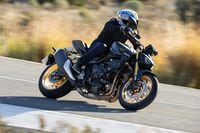World's Best? Test With A Twist — Mick Woolett was the first non-German journalist to ride the fabulous supercharged BMW presented to Walter Zeller, upon his retirement from racing. Here is Woolett's story...
According to the author; since the dawn of motorcycling, enthusiasts have debated what is best. Now that Woolett had ridden the bike presented to retired BMW works racing ace Walter Zeller argument can cease for a few years.
A year after retiring in 1957, BMW built and presented to Zeller a one-off bike to honor the seven years he successfully represented the Bavarian brand at the track. Photos circulated through the motorcycling press the previous year so when Woolett was planning a trip the the Austrian Grand Prix in Salzburg he reached out to the BMW Press Office. Carl Hoepner arranged the ride and asked Wollett to reach out to Walter when he arrived.
Late April of 1959 Mick showed up at the Zeller Steelworks in Hammerau deep in the heart Bavaria close to the Austrian border. Walter greeted him to chat about the machine and answer his questions.
One of the last 600cc supercharged engines built for sidecar racing in 1948-49 before the works sidecar engine size was limited to 500cc. The mill was tested by the factory to produce 72 bhp at 7200 rpm as compared to the 52-54 bhp produced by the BMW production racing machine motors of 1959. The supercharger was a vane-style unit was mounted to the front of the motor and produces 19 psi (1.4 atmospheres). Like most blown motors this one had an extremely low compression ratio of around four to one!
The fame was a modified racing frame to accept an older style shaft and plunger style spring system. Also of a slight vintage (for the day), an older set of forks was installed to help avoid the front mounted supercharger. Since the intention was for Zeller to travel on the streets with this machine, a battery-fed lighting system and a license plate bracket were also fitted to the bike. The only street accouterment not on this machine was a kickstarter, which required the machine to be bump started.
Zeller took a few laps around the steelworks before handing it off to our author. Having never ridden a supercharged machine before he took it easy at first but quickly realized the motor was “smooth and controllable” unlike most racing machines. With more confidence, Mick took the machine out through town and into the Bavarian countryside. He found the power completely manageable, the ergonomics (rearsets and clipons) spot on.
After a half hour Wollet reluctantly returned and was able to determine with the help of Zeller that at 6000 rpm, the author had seen around 112 mph. His impressions were that he would miss this machine. It was easy to ride, had plenty of usable power and was a comfortable steed. The only thing that made him feel better about every other machine he had ridden since this experience was the suspected price tag.
Parilla For 1960 — A fresh lightweight and refinements on other models. Seen at Laconia and sort of on accident were the 1960 Parilla models. Since the US distributor (Cosmopolitan Motors) had sold most of its 1959 model-year inventory, they had ordered the 1960 models to display at the annual New Hampshire show. Among the offerings was one new model: the lightweight Impala.
The Impala for 1960 was a 98cc overhead valve 4-stroke machine. The motor was characterized by an over-square bore and stroke and coupled to a 4-speed gearbox. Interestingly, there were two power options in the Impala. Available in either a 5 HP or 8 HP motor. The 8-horsepower machine had a claimed top speed of 68 mph at 6800 rpm. At an FOB price of $369, the little kitty would have western bars, a dual seat (passenger pegs to compliment the extended seat), something the referred to as “racing-type” shocks, speedo, underseat storage, and a stop light in three color combinations.
Updates to other machines included the new (in 1959) Speedster which in 1960 would be referred to as the Super Speedster have the Wildcat Scrambler motor, Grand Sport gas tank , larger dual seat, and turn signals. Available in red & white, or metallic blue & silver.
Ironically; in 1960, the Wildcat Scrambler would be fitted with the Grand Sport engine which would increase the available revs. The Clipper would also see some improvements as well. Among these was the replacement of the cylinder with an alloy one that was expected to offer a recognizable performance gain.










/cloudfront-us-east-1.images.arcpublishing.com/octane/BVYLWAXY7T7W6TTGW3PTDYEN3Y.jpg)
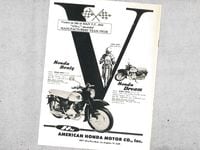

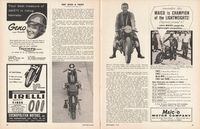
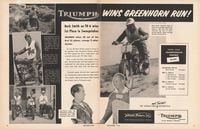

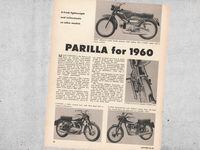


/cloudfront-us-east-1.images.arcpublishing.com/octane/OKWOJWAKP5EP3OACCRRWPCIX2Q.jpg)
/cloudfront-us-east-1.images.arcpublishing.com/octane/2WF3SCE3NFBQXLDNJM7KMXA45E.jpg)
/cloudfront-us-east-1.images.arcpublishing.com/octane/G4MG6OUCJNBSHIS2MVVOTPX65E.jpg)
/cloudfront-us-east-1.images.arcpublishing.com/octane/IIGGWFOTOJGB7DB6DGBXCCMTDY.jpg)
/cloudfront-us-east-1.images.arcpublishing.com/octane/QSTCM6AVEZA5JJBUXNIQ3DSOF4.jpg)
/cloudfront-us-east-1.images.arcpublishing.com/octane/U4I7G625B5DMLF2DVIJDFZVV6M.jpg)
/cloudfront-us-east-1.images.arcpublishing.com/octane/B6XD6LS6IVCQPIU6HXDJSM3FHY.jpg)
/cloudfront-us-east-1.images.arcpublishing.com/octane/ICL63FEDDRDTTMINYICCEYGMDA.jpg)
/cloudfront-us-east-1.images.arcpublishing.com/octane/FCGZHQXRBZFLBAPC5SDIQLVF4I.jpg)
/cloudfront-us-east-1.images.arcpublishing.com/octane/WNOB6LDOIFFHJKPSVIWDYUGOPM.jpg)

/cloudfront-us-east-1.images.arcpublishing.com/octane/X33NU3E525ECRHXLNUJN2FTRKI.jpg)
/cloudfront-us-east-1.images.arcpublishing.com/octane/6KKT5NNL2JAVBOXMZYS5ZO76YA.jpg)
/cloudfront-us-east-1.images.arcpublishing.com/octane/J5RKG5O455GMPGQRF2OG6LRT7A.jpg)
/cloudfront-us-east-1.images.arcpublishing.com/octane/GX2CIZKQVRH2TATDM26KFG2DAE.jpg)
/cloudfront-us-east-1.images.arcpublishing.com/octane/ZWIDYSAKQZHD5BHREMQILXJCGM.jpg)
/cloudfront-us-east-1.images.arcpublishing.com/octane/CYUHJZCTSJCH3MRAQEIKXK7SCQ.jpg)
/cloudfront-us-east-1.images.arcpublishing.com/octane/LKOFINY56FCXJCANJ5M7ZDQUBY.jpg)
/cloudfront-us-east-1.images.arcpublishing.com/octane/4NBPDACMWJH63JQYJVK3QRBDZI.jpg)
/cloudfront-us-east-1.images.arcpublishing.com/octane/KKHQHRR3FJGX7H2IPU6RALMWG4.jpg)

/cloudfront-us-east-1.images.arcpublishing.com/octane/5IOFS5JAE5FOXMNA23ZRAVVYUU.jpg)
/cloudfront-us-east-1.images.arcpublishing.com/octane/CGXQ3O2VVJF7PGTYR3QICTLDLM.jpg)
